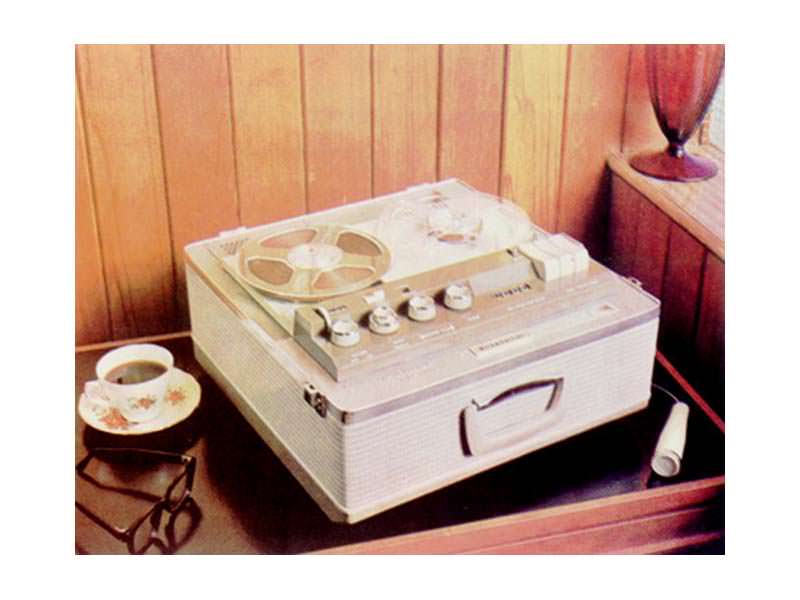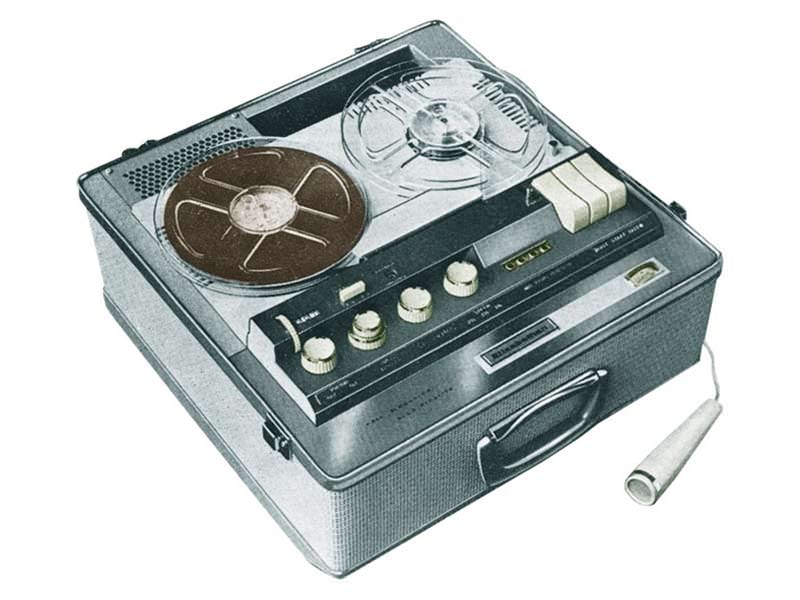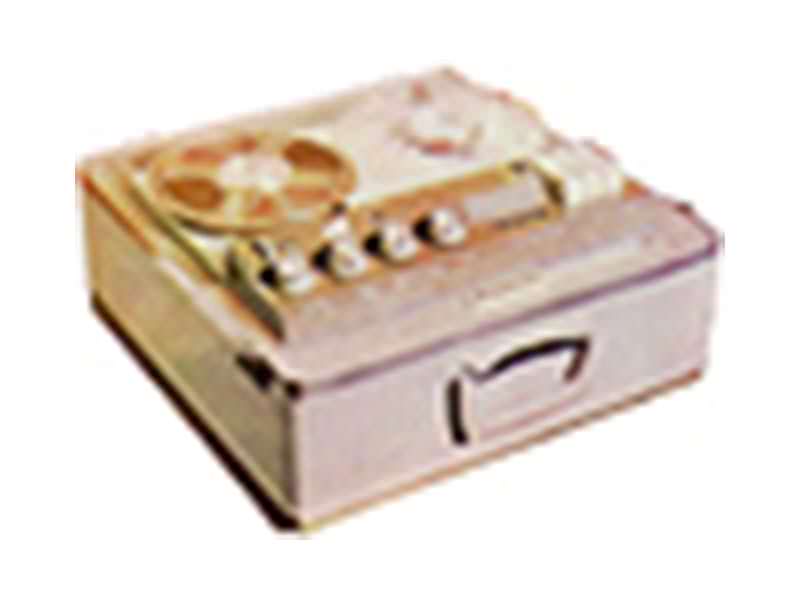Technical Details
Brand: Elizabethan (EAP)
Model:LZ 102
Category:Mid High Fidelity
Application:Consumer
Electronics:Solid State
Equalization:IEC
Country of Manufacture:United Kingdom
Release dates:1965 - 1968
Tracks:1/4 Rec/PB
Speeds: 1 7/8, 3 3/4, 7 1/2
Max Reel Size("): 7"
Number of heads: 2
Head Composition: Permalloy
Head Configuration: Mono - Full Track
Voltage(s): 220-240v
Frequency Response:(all 4 dB): 7½ ips: 60Hz - 15kHz
Wow and Flutter:(not greater than) 0.15% at 7½, 0.25% at 3¾
Signal-to-Noise Ratio:40 dB unweighted
Sound quality rating:5 / 10
Long-term reliability rating: 5/ 10
Additional Details
Description
The LZ 102 was a fully transistorized, quarter-track, 3-speed recorder aimed at the higher end of the consumer market and was built around the new Magnavox 363 Studiomatic tape deck.
Features included separate bass and treble controls, a 2-way internal speaker set-up (9 x 4¼” elliptical and tweeter) and a 4-watt amplifier output.
Reels up to 7″ inch in diameter could be accommodated.
Plaback equalization: CCIR playback at 7½ ips, 50–15,000 cps ±3 dB / Long term speed stability: better than 0.5% / Bias frequency: 50kHz / Rewind speed: 2 minutes for 1200ft / Audio output power: 4 watts / Inputs: microphone (crystal), sensitivity 2 mV gramophone, sensitivity 200 mV / Outputs: hi-fi – 250 mV. external speaker 15 ohms or headphones / Semiconductors: AC 107, AC 128, AD 149. OC 75, OC 44 / Speaker(s): 9 x 4½ ” elliptical plus tweeter / Dimensions: 16 x 16½ x 9″ (406.5 x 419 x 228.5 mm) / Weight: 26 lbs (11.8 kg) / quarter-track mono
Additional Info
From Tape Recording Magazine May 1966
It was with considerable anticipation and interest that I unpacked the Elizabethan LZ102, the first machine under this label to be reviewed by any audio journal for some five years.
The recent change in ownership of this company has resulted in a much mere co-operative attitude towards the audio journals, and we can now look forward to seeing more of their machines on the “Test Bench” for unbiased reports.
The LZ102 model is a mains-operated, fully transistorised recorder incorporating the new Magnavox 363 Studiomatic deck (reviewed last month). Three tape speeds are available, and it will accept tape spools of up to seven inches in diameter. Using the four-track system incorporated this provides a playing time of 32 minutes per track using standard-play tape (1200 ft.) at the fastest speed of 7½ ips; 64 minutes at 3¾ ips; and 2 hours 8 minutes at 1 ips.
Basically a mono machine, the LZ102will also play stereo tapes if an additional amplifier is provided for the second channel. It is provided with a crystal stick microphone and a lead for recording from external equipment such as a radio tuner or disc player.
Welcome feature, and continuing the trend among the latest machines, the LZ102 features all controls and connecting sockets on the front panel of the machine. Mounted on the deck plate, these are immediately available on removing the lid and overcomes that exasperating problem of fiddling with rear-mounted sockets.
The tape transport is controlled by three piano-type keys which operate in a manner slightly different from the usual method. These ‘rocker’ keys are activated by depressing the front edge to start any particular function and depressing the back edge to cancel it.
The three keys, from left to right, provide fast rewind, play/record, and fast forward wind. A pause control lever is immediately to the left of these keys. and the “record” function is selected by operating a spring-loaded knob which works in conjunction with the “start” control. This spring-loading ensures that the machine always reverts to play as soon as the tape is halted, thus guarding against the possibility of accidental erasure.
To the right of the “record” switch is the speed selector, and to the left are the concentrically mounted controls for bass and treble tone selection. These operate on the internal amplifier only.
To the left of these again is the volume control which doubles as the gain control when the equipment is switched to “record”. Immediately above is the three-digit tape position indicator and the two buttons tor track selection.
The input and output sockets are very simple, and only five in number. Four of these are grouped together between the speed selector and the deck keys, and the fifth, the second channel outlet for stereo, is next to the track selector buttons. The grouped sockets are, from left to right , microphone input, radio input, “hi-fi” output, and external loudspeaker. Inserting a plug in this last socket mutes the internal loudspeaker, and this socket can also be used for monitoring during recording with headphones. The output impedance is 15 ohms.
The output impedance at the “Hi-Fi” socket is not specified, but the level is quoted at 250mV, this output being unaffected by the volume and tone controls. The microphone input is of high impedance and has a sensitivity of 2mV; the radio input sensitivity is200mV. Record level indication is by means of a VU type meter.
It is encouraging to see a rather better loudspeaker system than is usual in a machine in this price range, The five transistor amplifier delivers four watts into two loudspeakers, one a 9 inch x 4½ inch.
The machine was given the usual practical and technical tests, and performed well. My favourite test for good quality reproduction, the piano, was well reproduced at all except the slowest speed, although naturally the 7½ ips was undoubtedly the best. Incidentally, I was pleased to find this speed present; so many otherwise excellent machines these days omit this, and it is really essential if high quality results are to be achieved. In this latter connection, I think it is a pity that this machine is designed to be used with a crystal microphone; a transistor amplifier naturally has a low input impedance, and it would have been very easy to make it suitable for one of the many low or medium impedance microphones now available.
The cost of such a microphone need not be high. The London Microphone Co’s LM-l00 reviewed in the March issue for example would have cost the manufacturers scarcely more than the crystal supplied. Asit is, the high impedance makes long microphone leads very difficult, if not impossible. Of course, a low impedance microphone can be used with a suitable matching transformer, but it is a pity that this should be necessary.
To return to the machine. Reproduction of tape records was good, and this is borne out by the response curve shown from the CCIR test tape. The record/ replay response curves show some deviation from the makers specification, but the quality is still good, especially at the 7½ ips speed. I would have expected better things at 3¾ ips, many machines available will do better than this. The response at the slowest speed is acceptable, as the makers suggest in their brief but adequate instruction leaflet, for the background reproduction of party music. The signal-to- noise ratio was just outside the specification at 38 dB. but was sufficient to give a useful dynamic range. Wow and flutter were satisfactory.
Other comments: the outward design and appearance of the machine were pleasing and it was well made and finished. I am not too happy that the now standard DIN socket for connection to external equipment was not included, and I felt that the positioning of the input and output sockets was such that the leads interfered with the operation of the controls But these are minor matters, and I consider the LZ102 to be worth the money at 49 guineas.
MANUFACTURERS’ SPECIFICATION
Frequency response : 60–15,000 cps ±4dB at 7½ ips; 60–8,000 cps ±4 dB at 3¾ ips: 60–5,000 cps ±4 dB a t 1ips. CCIR playback at 7½ ips, 50–15,000 cps ±3 dB. Wow and flutter: Not greater than 0.15 per cent at 7½ ips; not greater than 0.25 per cent at 3¾ ips. Rewind: Approx. Two minutes with tape supplied. Amplifier output: Four watts. Signal-to-noise ratio: 40dB unweighted. Inputs : Microphone (sensitivity 2 mV), and pick-tip (200 mV). Outputs: External loudspeaker (15 ohms) or monitor headphones; hi-fi (250 mV). Loudspeakers: 9 x 4½- inch elliptical and one tweeter. Transistors: AC 107, AC 128, AD 149. OC 75, OC 44. Dimensions: 16 x 16½ x 9 inches. Weight: 26 lb. Manufacturers: Elizabethan Electronics Limited, Crow Lane, Romford, Essex.
– By H. B. Hadden




